Side Menu:
Second Officer C.H.Lightoller - Titanic
Herbert Lightoller was delighted with the new assignment he received in early 1912. He was to travel to Belfast to accept the position of first officer of the RMS Titanic. According to his US Inquiry testimony he joined Titanic on "March 19 or 20", while the other officers, Pitman, Boxhall, Lowe and Moody joined the ship on March 27th. He was clearly impressed with what he saw:
“It is difficult to convey any idea of the size of a ship like the Titanic, when you could actually walk miles along decks and passages, covering different ground all the time. I was thoroughly familiar with pretty well every type of ship afloat, from a battleship and a barge, but it took me fourteen days before I could with confidence find my way from one part of that ship to another by the shortest route.”
Notably, as First officer, one of his duties involved testing the lifeboats:
Senator SMITH. Was a test of the lifeboats made before you sailed for Southampton?
Mr. LIGHTOLLER. All the gear was tested.
Senator SMITH. Were the lifeboats lowered?
Mr. LIGHTOLLER. Yes, sir.
Senator SMITH. Under whose orders?
Mr. LIGHTOLLER. The officers, principally my orders... All the boats on the ship were swung out and those that I required were lowered
down as far as I wanted them - some all the way down, and some dropped into the water.
Senator SMITH. I wish you would give the proportion that went into the water.
Mr. LIGHTOLLER. About six.
Senator SMITH. Six into the water?
Mr. LIGHTOLLER. Yes.
Senator SMITH. And the others lowered?
Mr. LIGHTOLLER. Part of the way - as far as I thought necessary.
Senator SMITH. Part of the way?
Mr. LIGHTOLLER. Yes.
Senator SMITH. Of course, part of the way would not do anybody much good on a sinking ship. I assume you did that for the purpose of trying the gear, and not for the purpose of testing the security of the lifeboats?
Mr. LIGHTOLLER. It is principally the gear that we test. The lifeboats we know to be all right.(25.)
At the British Inquiry Lightoller named the Board of Trade representative, Mr. Carruthers and noted:
"He examined the lifeboats, swung them out, lowered them down, hauled them up, and examined the equipment..and tested the big anchor forward, swung that out and back again. I think that is all the time I had with him. I was with him most of the time he was with the lifeboats really, of any consequence…Previously we had already taken a check of the full complement of the boats by the officers; the officers themselves had been through all the boats, and got a list... His report would be made to the Chief Officer.(24.)
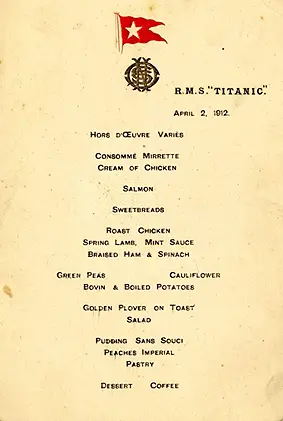
A menu of the lunch served during the sea
trials that Lightoller kept as a souvenir and
later gave to his wife, Sylvia. (Click to enlarge)
In addition to testing the lifeboats, First officer Lightoller saw "the watertight doors myself tested in Belfast; they were all in perfect working order (24.)" and was also in charge of ammunition. He later wrote about this in his book:
"All the navigation instruments fell to my lot, as also did firearms and ammunition. These latter are looked on mostly as ornaments in the modern ship. Revolvers, rifles and bayonets in the Merchant Service, are rather superfluous. A man governs by accepted discipline, tact, his own personality, and good common sense. We have no King’s Regulations to back us up; neither do we need them; nor yet do we require firearms, except on the rarest occasions. Curiously enough, the Titanic was to prove the only occasion at sea that I have ever seen firearms handed out, and even then it was not Britishers they were used to influence.""(47.)
Titanic's sea trials, abbreviated due to weather conditions, took place on the 2nd of April, 1912, during which Lightoller was stationed at the after end of the ship. According to a menu Lightoller kept as a souvenir, the senior officers enjoyed a lunch including consommé mirrette, sweetbreads and spring lamb. He later gave the menu as a gift to his wife, Sylvia, when he left Southampton on 10 April 1912. The menu was auctioned in 2003 when it sold for £28,000 at Sotheby’s, and had been consigned by Lightoller’s descendants, who said it had been given to his wife Sylvia as a souvenir as he departed from Southampton on April 10. In 2018 it was auctioned again and sold for a hammer price of £80,000, a record for a menu from the ship.
With all tests meeting the Board of Trade standards, the Titanic sailed that very night at 8pm destined for Southampton, her port of embarkation, arriving on April 3rd. According to Lightoller's British Inquiry evidence, "from Belfast round to Southampton we averaged about 18 knots... Perhaps 18 ½’ I do not think she got much higher than that."(24.)
Southampton
The ship was then 'heeled for stability'. Lightoller describes the process:
"The builders knowing the exact weights on board, additional weights are placed on each side of the ship. A pendulum is suspended in the most convenient place in the ship with a plumb on the end of it, and a method of registering the difference with the plumb line; a number of men then transfer the weights from one side of the ship to the other, bringing all the weight on one side and transferring the whole of it back again; and with this, I believe the builders are able to draw up a stability scale."(25.)
In addition, in his role as First Officer his duties involved signing on the crew, including checking the eye test certificates of the look-outs. At the British Inquiry Lightoller stated:
"If I am First Officer of a ship, a First Officer has the signing on of the crew... as far as possible and practicable, I see that these look-out men, at stated periods, have an eye test... there were some of those men I knew to have had eye-tests, that is to say they were look-out men - Fleet and Symons who had been with me in the “Oceanic”…it is the customary test by the Board of Trade. They go up there and obtain their certificate."(24.)
Lightoller's Demotion
Then, only a few days before sailing day, there was a surprising announcement. At the last moment, Captain Smith reshuffled the senior crew's positions to accommodate Henry Tingle Wilde as Chief Officer (as he had been aboard Olympic). This meant that Chief Officer William Murdoch was bumped down to the position of First Officer, and Herbert Lightoller to Second Officer, while David Blair was left out entirely, the other officers remaining the same. Lightoller was not pleased by the demotion in position nor the change in compensation to ₤14, fully ₤3 10s less than what he was anticipating:
"Unfortunately, whilst in Southampton, we had a re-shuffle amongst the Senior Officers. Owing to the Olympic being laid up, the ruling lights of the White Star Line thought it would be a good plan to send the Chief Officer of the Olympic, just for the one voyage, as Chief Officer of the Titanic, to help, with his experience of her sister ship. This doubtful policy threw both Murdoch and me out of our stride; and, apart from the disappointment of having to step back in our rank, caused quite a little confusion. Murdoch, from Chief, took over my duties as First, I stepped back on Blair’s toes as Second, and picked up the many threads of his job, whilst he,--luckily for him as it turned out—was left behind. The other officers remained the same. However, a couple of days in Southampton saw each of us settled in our new positions and familiar with our duties. Board of Trade surveys were carried out to everyone’s satisfaction.”(47.)

This crew document shows the officer reshuffle.
Later, in October 1912 in an article for Christian Science Sentinel, Lightoller described the demotion further, with possible reasons for the re-shuffle:
Murdoch had been appointed chief, I was first and Blair was second officer; in that rank we had joined the Titanic in Belfast. Shortly before we sailed from Southampton, Wilde, who was formerly chief of the Olympic, and who was to have been given command of another of the White Star steamers, which, owing to the coal strike and other reasons was laid up, was sent for the time being to the Titanic as chief, Murdoch ranking back to first, myself to second, and Blair standing out for the voyage. (Christian Science Sentinel, October 1912)
On April 9th, the day upon which Lightoller's demotion officially took place, the Board of Trade Emigration Officer Maurice Clarke boards Titanic. He is assisted by Lightoller and Murdoch for many hours as he carefully checks to make sure that Titanic meets safety requirements. Lightoller, when giving evidence at the US Inquiry, did not hide his displeasure:
"Capt. Clark, we call him a nuisance because he is so strict... Because he makes us fork out every detail... He would insist upon them all being absolutely brought out on deck every time... the whole of the ship's life-saving equipment... Life preservers throughout the ship, all the boats turned out, uncovered, all the tanks examined, all the breakers examined, oars counted, boats turned out, rudders tried, all the davits tried - there was innumerable detail work...The boats lowered, put in the water, and pulled out, and brought back again, and if he was not satisfied, sent back again. Life belts in every room, in every compartment, where, as we say, there was habitation, where a man could live."(25.)
During the British Inquiry Lightoller noted that "in Southampton as well we put boats in the water and the men were put in...Probably 8 and a quartermaster in each boat...Two boats...We lowered two boats, that is swung out, carried on with the crew, swung out the boats, lowering away, placing the crew in the boats, the crews with their lifebelts on, lowered the boats, released them, sent them out, brought them back to the ship, and hoisted them inboard again and secured them."(24.)
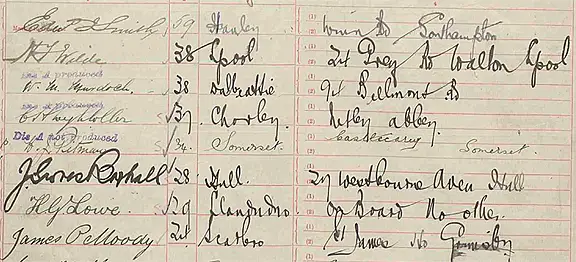
Titanic's Crew Agreement document, with the signatures of Captain Smith and his officers, courtesy of National Archives, UK.
The new Chief Officer, Henry Tingle Wilde, had arrived aboard ship sometime on or just before the 7th of April, and was involved in coaling, crew recruitment, cargo loading and loading of food supplies had already taken place. According to author J. Kent Layton in his book On A Sea of Glass: The Life & Loss of the RMS Titanic, Lightoller (and also most likely Murdoch) do not have time to change their uniform rank insignia before the voyage (as seen in a photograph taken on 11 April), causing later confusion among crew and passengers alike. Consequently, on sailing day, April 10th, 1912, when Titanic began her maiden voyage, Lightoller, now Second Officer but still in his First Officer's uniform, found himself stationed on the forecastle with Chief Officer Wilde, rather than astern as during the sea trials.
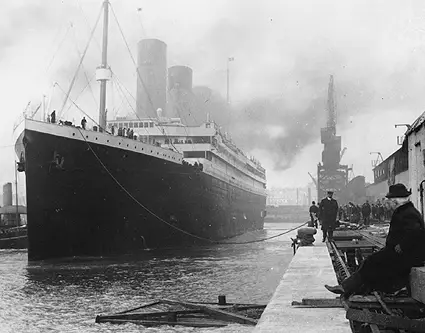
Titanic departing Southampton docks.
(Click image to enlarge)
Lightoller subsequently witnessed first hand the powerful effect of these new, large luxury liners. As the Titanic steamed along the River Test, the water displacement caused all six mooring ropes on the New York to break and her stern to swing toward Titanic. Quick action averted a collision by only four feet. Lightoller later wrote in his book, incorrectly naming the New York
“The Oceanic and St. Paul (sic) were lying moored to the wharf alongside each other. They happened to be in a position where the Titanic had to make a slight turn, which necessitated coming astern on her port engine. The terrific suction set up in that shallow water simply dragged both these great liners away from the wharf. The St. Paul(sic) broke adrift altogether, and the Oceanic was dragged off until a sixty foot gangway dropped from the wharf into the water. It looked as if nothing could save the St. Paul crashing into the Titanic’s stern—in fact, it was only Captain Smith’s experience and resource that saved her. The Titanic, of course, dwarfed these two ships, and made them look like cross-channel boats, and the wash from her screws had a corresponding influence. Just as a collision seemed inevitable, Captain Smith gave the Titanic a touch ahead on her port engine, which simply washed the St. Paul away, and kept her clear until a couple of tugs, to our unbounded relief, got hold, and took her back alongside the wharf.”
Although the near collision delayed departure for about an hour while the drifting New York was brought under control, the Titanic arrived four hours later at 6.35pm in the French port of Cherboug. Due to the size of Titanic and the lack of suitable docking facilities at Cherbourg the White Star Line operating two tenders -the SS Traffic and the SS Nomadic. Within 90 minutes 274 passengers boarded Titanic and 24 departed aboard the tenders.
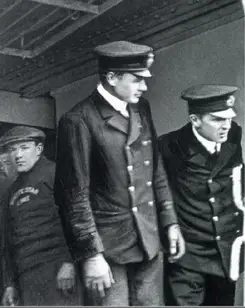
Lightoller and Murdoch (right) prepare to
close the gangway before departure from
Queenstown, Ireland, April 11th, 1912.
It is the last photograph of Murdoch or
any Titanic officer ever seen on duty.
(Click image to enlarge)
Finally at 8:10 p.m Titanic departed Cherboug bound for Queenstown, arriving at 11.30 am on Thursday 11 April at Cork Harbour on the south coast of Ireland. Once again the docking facilities were not sufficient for a ship the size of Titanic and tenders were used to bring 113 third class and seven second class passengers came aboard, while seven passengers departed.
It was here the last known photograph of Titanic's crew was taken as Lightoller and Murdoch prepare to close the gangway before departure from Queenstown.
Captain James McGiffin was the superintendent of Queenstown and he paid a visit on board the Titanic to salute his former shipmates and friends Lightoller and Murdoch during their stop there, it is tantalizing to think that this photograph depicts Lightoller and Murdoch bidding McGiffin farwell as he leaves Titanic on a tender.
Titanic weighed anchor for the last time at 1.30 pm and departed Queenstown on her westward journey across the Atlantic. Lightoller had overseen aspects regarding cargo, but now that they were fully at sea, such responsibilities were delayed once again until they reached New York. And he was impressed by the quality of the ship, writing: "Each day, as the voyage went on, everybody’s admiration of the ship increased; for the way she behaved, for the total absence of vibration, for her steadiness even with the ever-increasing speed, as she warmed up to her work."(47.)
The Lookouts and the Missing Binoculars
After leaving Southampton and 'clearing the Nab Lightship' (east of the Isle of Wight) George Symons, a lookout, asked Lightoller for binoculars. During the British Inquiry he reported:
Symons: After we left Southampton and got clear of the Nab Lightship I went up to the officers’ mess-room and asked for glasses. I asked Mr. Lightoller, and he went into another officers’ room, which I presume was Mr. Murdoch’s, and he came out and said, “Symons, there are none.” With that I went back and told my mates.
Attorney-General: Was there a place for them in the “Titanic”?
Symons: Yes, a box in the port after corner.
Attorney-General: Of the crow’s-nest?
Symons: Yes.(24.)
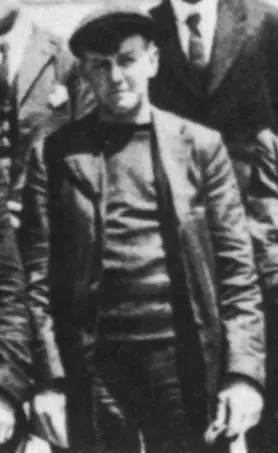
Lookout George Symons, asked Second Officer
Lightoller for binoculars, who in turn asked Wilde.
Lightoller himself remembers the conversation with Symons and testified at the British Inquiry
I was in my room, and I heard a voice in the quarters speaking. I recognised it as Symons, the look-out man, so I stepped out of my door, saw him, and said, “What is it, Symons?” He said, “We have no look-out glasses in the crow’s-nest.” I said, “All right.” I went into the Chief’s room, and I repeated it to him. I said, “There are no look-out glasses for the crow’s-nest.” His actual reply I do not remember, but it was to the effect that he knew of it and had the matter in hand. He said that there were no glasses then for the look-out man, so I told Symons “There are no glasses for you.” With that he left.(24.)
It was possibly not the first time Lightoller had been asked about the binoculars as Lookout Frederick Fleet also knew about a request. During the US Inquiry he was questioned on this point:
Senator SMITH. Did you make any request for glasses on the Titanic?
Mr. FLEET. We asked them in Southampton, and they said there was none for us...
Senator SMITH. Whom did you ask?
Mr. FLEET. We asked Mr. Lightoller, the second officer.
Senator SMITH. Did you make the request yourself?
Mr. FLEET. No; the station lookout men did, Hogg and Evans.
Senator SMITH. How do you know they made it?
Mr. FLEET. Because they told us.
Senator SMITH. Where did they tell you; after leaving Southampton?
Mr. FLEET. In Southampton, and afterwards.
Senator SMITH. You expected glasses?
Mr. FLEET. We had a pair from Belfast to Southampton.
Senator SMITH. You had a pair of glasses from Belfast to Southampton?
Mr. FLEET. Yes, sir; but none from Southampton to New York.
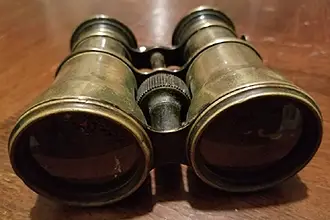
White Star Line binoculars used by the first officer
of the SS Runic (1900-1940) made by JW Ray & Co.
the same company that made and supplied Titanic's
engine telegraphs. (Click to enlarge)
Also during the British Inquiry, Lightoller noted that they had binoculars on the bridge "a pair for each senior officer...and the Commander, and one pair for the bridge, commonly termed pilot glasses." When asked if he would have provided the lookouts binoculars he replies "Had they been on the ship I might have done."(24.)
However on day 5 of the US Inquiry Lightoller was quite clear that he placed no reliance on the lookouts anyway:
We place no reliance on them... They are there to keep a lookout; to assist you… I keep a lookout myself, and so does every other officer. ..Occasionally a man will see a light or a vessel first, particularly in daytime, when naturally we trust to them seeing. Especially all through the daytime lookout men are keeping a keen lookout, and will report a steamer long before she is in sight, apparently, by her smoke. In that instance the lookout might be very useful. In nighttime, particularly in channels where there are a great many lights, we may be watching one light, and there may be another light in our course, and the man in the crow's nest will strike, say, one bell. That signifies something on the port bow, and calls our attention to it. So that the ship can approach close to us without the bridge being notified, even though the officer has not himself already seen it. The White Star Co., I may say incidentally, is the only company in the world, so far as I know, that carries six lookout men. We carry men who do nothing else, night and day, from the commencement to the finish of the voyage, except keep a lookout. They are two hours on and four off.(25.)
On another occasion during the US Inquiry he added that the "lookouts receive so much per month, the same as the men, and then they get 5 shillings per voyage of what we call "lookout money"…. Not only that, but they got other unofficial benefits… Speaking for myself, I always select old lookout men that I know; and as a rule, the lookout men run perhaps a year in the crow's nest in one ship. For instance the men I had with me on the Titanic had been with me on the Oceanic for years, doing nothing but keeping a lookout. They have their other special duties at other times, as well….This is what I wish thoroughly understood, that the officer does not rely on the lookout to the extent of sitting down and having a smoke or anything like that. He keeps his own lookout." (25.)
Regular tests of the water temperature were being taken during the journey. At the US Inquiry Lightoller explained that "a test is taken of the water every two hours from the time the ship leaves until she returns to port…By drawing water from over the side in a canvas bucket and placing a thermometer in it… It is entered in a book."(25.)
According to Lightoller's BBC broadcast in 1936 "From the moment we left Belfast we had marvellous weather. And even when we got out on the Western Ocean or Atlantic as you probably know it, it was as smooth as the proverbial millpond. Not a breath of wind and the sea like a sheet of glass." (BBC, 1936)